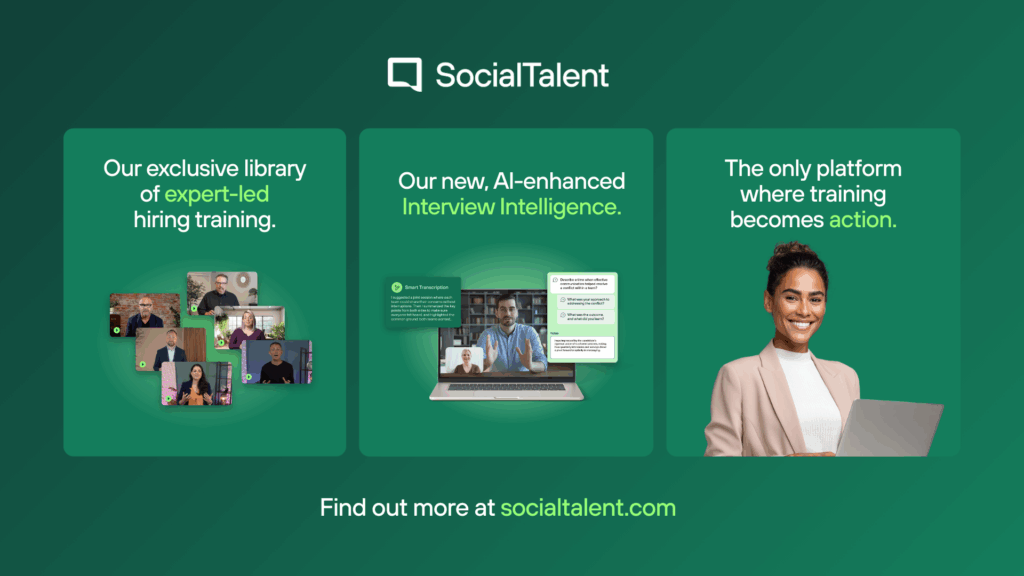
By Johnny Campbell
You’ve heard us say it before – interviews are broken. You know it. We know it. Every hiring manager who’s ever sat through a rambling, unstructured conversation that somehow decides someone’s career trajectory knows it too.
For too long, we’ve accepted that “good interviewing” is some mystical art form that only a chosen few can master. That consistency across your hiring process is a nice-to-have, not a must-have. That the gap between what we teach in training and what actually happens in those crucial 60 minutes is just… the way things are.
Well, here’s your reality check: It doesn’t have to be.
We’ve spent almost 15 years helping organizations like Pfizer, Cisco, and Siemens build better hiring practices. And here’s what we’ve learned: Training is only half the battle. The real magic happens when you can bridge that gap between learning and doing, right there in the interview.
That’s where Interview Intelligence comes in.
Interview Intelligence: How We’ll Turn Every Interviewer Into Your Best

Here’s the thing about great interviews, they’re not accidents. They’re the result of structure, consistency, and real-time intelligence working together.
Our Interview Intelligence platform doesn’t just give you another tool to manage. It gives you:
Consistency across every interview – Structured frameworks ensure fairness, compliance, and quality across all roles and geographies. Your London office interviews with the same excellence as your Austin team.
Collaboration made easy – Shared feedback loops align hiring managers, recruiters, and stakeholders around unified decision-making processes.
Bias reduction at scale – Tools that help interviewers recognize and mitigate unconscious bias, supporting more inclusive hiring across your entire organization.
The bridge between learning and doing. Track whether interview training is being applied in live interviews, while ongoing prompts keep interviewers aligned with best practices long after certification.
Smarter insights in real time. AI-powered analysis highlights strengths, gaps, and improvement opportunities. Post-interview learning recommendations provide hiring managers with clear guidance on where and how to develop further.
Intelligence + Expertise: The Complete Package
But here’s where it gets even better. Interview Intelligence doesn’t just give you the platform – it comes bundled with our most effective training for hiring managers.
We’re talking about three cornerstone learning paths that transform how your team approaches hiring:
Licensed Hiring Manager – builds strategic expertise in developing effective hiring criteria, implementing talent selection processes that raise the bar, and making fair, quality hiring decisions that stick.
Licensed Inclusive Interviewer – equips your team with intentional language and approaches that make every candidate feel valued, while providing practical techniques for recognizing and mitigating bias throughout the process.
Licensed Interviewer – develops core interviewing capabilities using behavioral and situational techniques that actually predict candidate success, moving your team from basic to expert-level interviewing skills.
The result? Your hiring managers don’t just get access to intelligent tools, they get the foundational expertise to use them effectively. It’s the complete bridge between learning and doing, packaged together and designed to work seamlessly.
More Than Just a New Look

We’re also unveiling our new brand identity, and it’s not just a fresh coat of paint.
This rebrand represents our evolution from a training company to the first enterprise-grade hiring excellence platform. It’s bold, modern, and reflects exactly where we’re heading: a future where every hiring decision is backed by intelligence, not just instinct.
Our new brand embodies what we’ve always stood for, empowerment, innovation, and putting humans at the center of everything we do. But now it also signals something bigger: our commitment to giving you the skills AND the intelligence you need to hire smarter, faster, and fairer.
What This Means for You
The future isn’t coming, it’s already here. Organizations that master interview intelligence now will have a massive competitive advantage over those still winging it with outdated processes.
We could list other vendors and compare features… but you’re already in the right place. You’ve been trusting us to upskill your teams for almost 15 years. Now we’re making sure that expertise follows them into every single interview.
Ready to see what interview intelligence looks like in practice?
In a world where every hire matters more than ever, hoping for good interviews isn’t a strategy. Having the intelligence to guarantee them is.
Discover Interview Intelligence and explore our new brand at socialtalent.com



